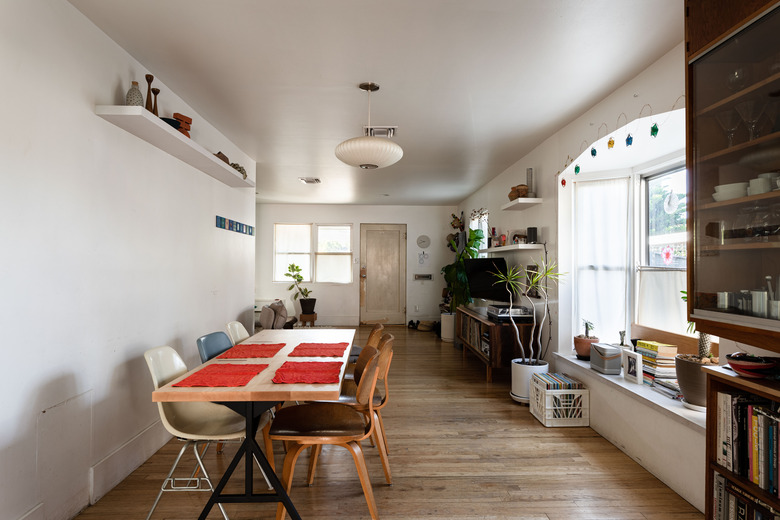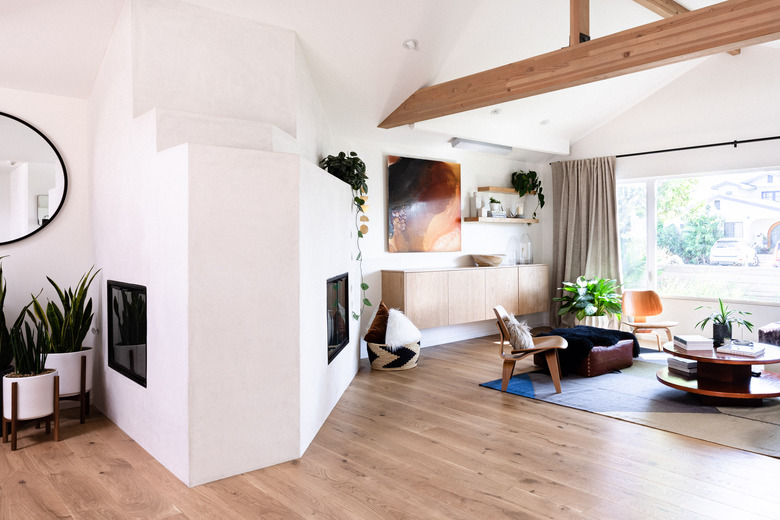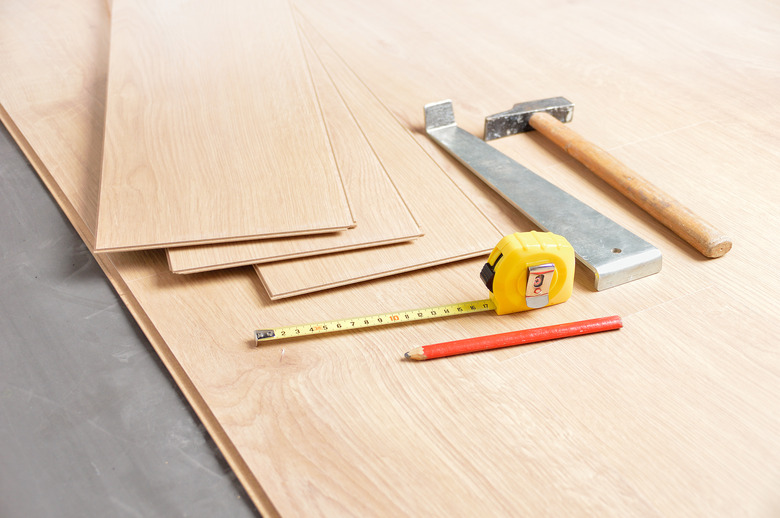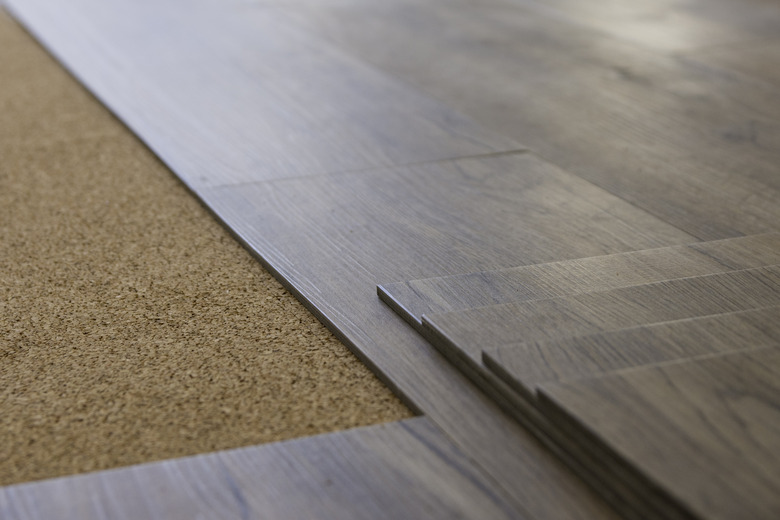Vinyl Vs. Laminate Flooring
When shopping around for new floors, you may find people using the terms "laminate flooring" and "vinyl flooring" interchangeably. The materials are similar, but there are some key differences between the two, and they're important to know. For example, vinyl is waterproof and laminate is not. This distinction may not matter much in your living room, but it will make a world of difference if you're putting the floor in your bathroom, laundry room or kitchen.
Further complicating the issue is that you have three types of flooring from which to choose rather than just two. Laminate flooring is fairly straightforward, but there are two types of vinyl flooring for you to consider. The key to choosing the right floor is to do your homework before you start shopping. That way, you'll know what you're looking at when you're in the store perusing your choices.
Vinyl and Laminate Flooring 101
Vinyl and Laminate Flooring 101
Vinyl flooring is a man-made product built in layers. The back or bottom layer consists of felt or another backing material that holds adhesive well. The next layer is PVC (polyvinyl chloride) plastic, which adds flexibility and give. The floor's pattern and color are applied to the PVC and then a protective top wear layer prevents fading and guards the floor against scratches and stains.
Luxury vinyl is thicker than traditional vinyl and has more give, so it's more comfortable for standing. Luxury vinyl also boasts a thicker wear layer to withstand high-traffic areas.
Like vinyl flooring, laminate is a man-made material. The difference is that while the middle layers of vinyl tiles, sheet vinyl and vinyl plank flooring are made of plastic, manufacturers fashion the center layer of laminate from high-density fiberboard. Made of wood fibers and resin, high-density fiberboard adds both thickness and warmth to laminate flooring that vinyl lacks.
Read more: Vinyl Flooring: What You Need to Know
Benefits of Both Flooring Types
Benefits of Both Flooring Types
There are many things that both vinyl and laminate flooring do well. Both materials can closely mimic the look and texture of natural flooring materials like wood and stone. In fact, these products mimic hardwood so well that most people can't tell the difference. When they can, the New Home Buyers Network claims it's often because of an imperfection or stain in the genuine wood rather than an issue with the laminate's appearance.
Of course, natural isn't the only choice. Both floors come in a wide variety of colors and patterns so you can find a floor to match your taste and style no matter what you like. Both floors also withstand foot traffic, kids and pets well and are easy to clean and maintain.
Laminate and vinyl also share similar prices. As of 2019, Home Advisor estimates the cost of luxury vinyl tiles at $2 to $7 per square foot and prices laminate flooring at $1 to $5 per square foot. Professional installation adds $3 to $10 per square foot for both. You can save a bit of money by opting for sheet vinyl, which costs only 50 cents to $2 per square foot.
The Difference Between Laminate and Vinyl Flooring
The Difference Between Laminate and Vinyl Flooring
The main difference is how they cope with water. Vinyl flooring is waterproof, making it an excellent choice for bathrooms and kitchens. Laminate flooring, however, is only water resistant. To avoid potential damage to both the laminate floor and the subfloor underneath, it's very important that you clean up wet spills promptly and keep laminate floors out of rooms like the bathroom where a lot of water is present.
This difference comes into play at cleaning time. Both floors require sweeping and steam cleaning to look their very best. Vinyl may need mopping occasionally, while a wet mop should never touch laminate floors.
Laminate floors also require a bit more support than vinyl. Vinyl has more flex than laminate, allowing it to more readily mold itself to the shape of an imperfect subfloor. Because it is made from fiberboard, laminate is stiffer and tends to break rather than bend when put under pressure. This means you'll need to be more careful about the quality of your subfloor and use an underlayment when choosing laminate.
Some Installation Insight
Some Installation Insight
Installation of both vinyl and laminate floors make good DIY projects for those with moderate home improvement skills, but sheet vinyl requires a unique approach. To install it, make a paper template of your floor and use it to accurately cut your vinyl. Once cut, take the vinyl sheet inside, smooth it over your floor and glue down the material. You can glue the entire floor one half at a time or opt for a floating installation by gluing only the edges of the floor.
Laminate flooring always comes in planks, but you can get luxury vinyl tiles, or LVT. To install them, use a chalk line to mark the center of your floor. Lay your first four tiles in a square pattern so that the corners meet at this center mark and then work your way out to the edges of the room, securing the tiles with glue or their own self-adhesive backing. Cut the tiles as needed where they meet your walls.
When using laminate and vinyl plank flooring, lay the first two rows of the floor against the wall, alternating the seams. When you're happy with the look and spacing, cut the tongues off the first row and place the tongueless planks against the wall. Continue placing the planks in rows, snapping the tongue-and-groove system together as you go. For a more randomized look, start each new row with a cut plank. A sharp razor knife will work on vinyl tile, but you'll need a saw to cut through laminate.
Read more: How to Install Vinyl Plank (LVP) Flooring
Brands to Consider
Brands to Consider
No matter how good your flooring installation job, a low-quality floor won't look as good as a higher-quality option. It's tempting to cut corners when you're on a budget, but choosing a trusted brand will make a difference in your floors.
When it comes to laminate, many homeowners choose Pergo since it invented the product and knows it better than anyone. Quick-Step is also a popular choice, having invented the click-lock system that most tongue-and-groove plank systems use today. Shaw and TrafficMASTER are also ranked highly for quality and design choice offerings. Ultimately, any brand that holds a certification from the North American Laminate Floor Association is a good choice.
It's of note that vinyl flooring preceded laminate to the market. Many laminate floor manufacturers were in the vinyl flooring game before they started making laminate flooring, creating an overlap. Shaw, Pergo and Mohawk all make vinyl flooring as well as laminate and have excellent reputations for both. Armstrong is also an excellent choice for vinyl floors. The company offers a massive variety of designs and is often praised for its reasonable pricing.
References
- Home Advisor: Laminate vs. Vinyl Flooring: Pros, Cons & Differences
- Home Advisor: How Much Does It Cost To Install Vinyl & Linoleum Flooring?
- Ferma Flooring: Luxury Vinyl vs. Laminate Flooring – What's the Difference?
- BuildDirect: Vinyl vs. Laminate: What's the Difference?
- Home Flooring Pros: Best Laminate Flooring Reviews
- New Home Buyers Network: How to Tell the Difference Between Hardwood and Laminate Flooring



